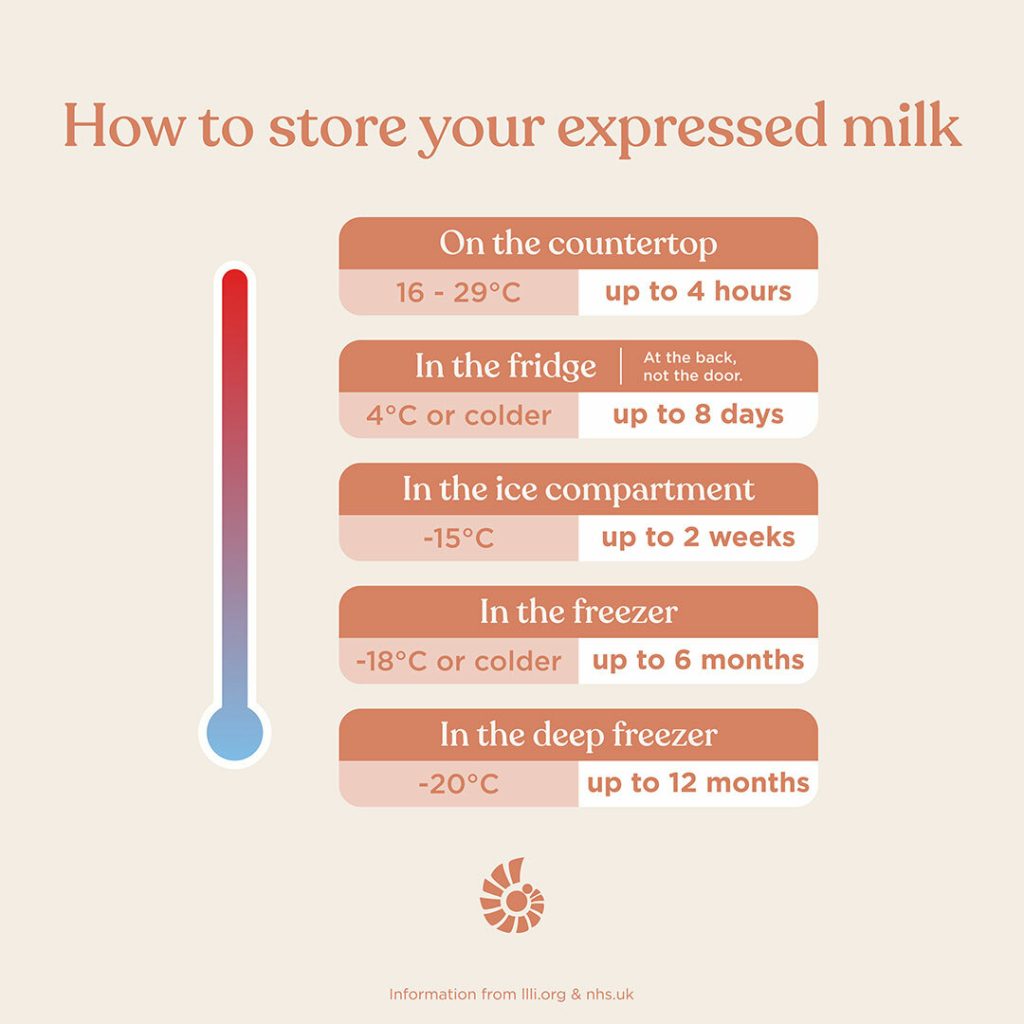
Many parents who embark on a breast/chestfeeding journey come across a pump at some point. Whether your feeding journey doesn’t get off to the start you hoped it would, or you want to try introducing a bottle, or because exclusively pumping is your first choice, whatever the reason, having an efficient tool for expressing milk can be a real help.
In addition to the important first hour after birth, during which your newborn baby goes through the nine stages of adaptation, expressing milk can also play a decisive role in the start of your feeding journey. Before the birth, however, your milk is not pumped, but expressed by hand, to extract valuable colostrum.
So that you feel well prepared and informed about expressing milk, we will be sharing all our knowledge about expressing milk with you together with our midwife and breast/chestfeeding expert Katrin.
What we’ll be covering:
- Why you might want to try expressing milk
- Finding the right chest / breast pump for you
- When to start expressing milk
- Pumping processes/schedules
- How to store your milk
- How to use your milk
Expressing milk and breast/chestfeeding, a good combination
So, other than the reasons we mentioned above, why might expressing milk – either exclusively pumping, intermittently, or in combination with direct feeding – be necessary? (This list isn’t exhaustive):
- You want someone else to feed baby and want to use your own milk.
- Your baby has sucking difficulties, either generally or on one side.
- Your baby refuses to feed from you.
- You want / need to increase the amount of milk you are producing.
- You have given birth to multiples.
- You had a premature birth or have a sick baby.
- You want to relieve the initial speed of your let-down with a low vacuum.
- You are separated from your baby for medical reasons.
- You have feeding problems, e.g. engorgement or mastitis.
- You are regularly using a nipple shield (pump 1-2x/day for additional stimulation in the first few days).
- You do not want to breast/chestfeed your baby but would still like them to receive human milk.
- You would like to donate milk.
- You need to take medication that prevents you from continuing to breastfeed.

Which is the right chest / breast pump for you?
Once you’ve decided to express then you need to choose your pump. But which is best? Manual or electric? Double pump set or single pump? It all depends on why you need it, how much milk you want to express, where you want to use it, and how long for. There are two main types of pump:
- The hand or manual chest / breast pump
A manual pump is suitable for occasionally expressing milk between feeds. It is portable and doesn’t require electricity. So, if you only want to express milk briefly on one side at a time and otherwise feed baby directly, a hand pump works well.
- The electric chest / breast pump
The electric pump is often larger and intended for long-term use. If you want to express on both sides and probably over a longer period of time, or even exclusively, then this pump is for you. Pumping milk from both sides at the same time (with a double pump) has several advantages. As a guide, you will obtain 18% more breast milk due to the release of oxytocin and the breast milk contains 1% more fat. You will also finish expressing more quickly (twice as fast). You may be able to hire an electric pump. Your midwife, health visitor or a local breastfeeding supporter can give you details of pump hire services near you. Or of course you can buy one.
There are two main types, those that plug into the wall, often called “hospital grade” pumps, or those that are battery powered and allow you to go hands-free. Both can be available in either single or double flange options and which one is right for you depends on where you’ll be pumping and how often. For example, hands-free pumps are lighter and powered by a rechargeable battery. You can simply carry them with you in your bra. This makes you more flexible, you are not tied to the bed or sofa, and you can also pump electrically when you are out and about. Some are less powerful than traditional pumps, so you would need to pump more often and for longer to express the same amount of milk, but this is changing as technology advances! It’s worth comparing models to see what might suit you best.
There are also small electric breast pumps that resemble a hand pump. These are particularly practical when travelling, if you only need to express milk occasionally and don’t want to pump manually.
Important! Make sure that you get a suitable flange size! If it is too small, the milk ducts in the nipple will be compressed and the nipple will not be able to move freely in the suction tunnel. This ultimately damages your nipple and surrounding tissue. If the shield is too large, the milk ducts around the areola are compressed and too much tissue enters the sucking tunnel. This means you will produce less milk. It is therefore essential to clarify which breast shield size is right for you.
When to start expressing milk
If you’re planning to pump, either exclusively or alongside direct feeding, in the first few days after birth, a transition to expressing with an (electric) pump takes place and manual collection (collection of breast milk by hand) is continued during the first few days in parallel with expressing until milk production has increased significantly. To get your milk production going, it is important to directly feed or pump as early as possible and as much as is possible or necessary. Always start with the minimum suction strength, which is then increased according to your needs up to the maximum comfortable vacuum. The pumping process should never be painful. Exactly how you pump always depends on the situation you are in.
How often should you pump if you are exclusively pumping?
If you are exclusively pumping, then start as follows:
Within the first hour after the birth, you first express colostrum by hand. You should also start pumping within the first six hours after the birth.
In the first 24 hours, pump at least 8x/preferably 10x, then up to 12x in the following 24 hours, including once or twice at night. The decisive factor here is achieving a sufficient quantity of milk. You should allow about 15 minutes for each side. If you pump the milk from both sides one after the other, you will need about 30 minutes. In any case, an oxytocin-stimulating chest/breast massage should be performed before pumping, and pumping should be interrupted by breaks with further massages (to increase the amount of milk).
You should continue with this rhythm until you produce enough milk after about 14 days, i.e. at least 500-700ml, preferably 750-1000 ml in 24 hours. However, please make sure that you have a 4-to-5-hour break during the night so that you don’t get overwhelmed.
Once the milk is flowing successfully and sufficiently, you should pump at least 5 times, preferably 6-8 times in 24 hours. Ideally with a double pump set.
How often should you express when also breast/chestfeeding?
If you only want to express milk on demand, the following applies:
Depending on your baby’s drinking rhythm, approx. 15 minutes with the double pump set, after feeding or in between.
Pumping correctly: what you need to look out for
As the hormone oxytocin is important for milk to be produced and flow well, all measures that stimulate the release of oxytocin are helpful when pumping. When breast/chestfeeding, your baby does this: they lie warm against you, smell good and stimulate feelings of love and affection. The following measures also have a supportive effect when expressing milk: a comfortable posture, possibly a nursing bra with holes for the pump, breast/chest massages, short breaks, being close to your baby, possibly a photo/video of your baby, something that smells like them, a heat pack or warm cloth and a delicious drink. This stimulates the release of oxytocin much more effectively than continuous pumping over a longer period of time. To build up and maintain a good quantity of milk and for pain-free pumping, it makes sense to pump in several successive pumping episodes, interspersed with breaks for stimulating massage. This type of pumping is also known as interval pumping or power pumping. There are various recommendations regarding the exact procedure for interval pumping. The EISL (Europäisches Institut für Stillen und Laktation) uses the following terms:
Power pumping according to Arnold:
We recommend this method as a standard method for your everyday life:
- breast/chest massage / oxytocin massage
- double-sided pumping for approx. 5 minutes
- short interruption (drink a glass of water, stretch, stand up to increase the release of oxytocin)
- repeat points 1-3 a total of 3 times
- Pump down time: 15-20 minutes.
If you can express a few millilitres of milk by hand after the power pumping (alternating right-left-right-left), these are particularly rich in fat.
Cluster pumping according to Walker:
Are you wondering how to get more milk when pumping? Then we recommend this method once a day as a supplement:
- breast/chest massage / oxytocin massage
- double-sided pumping for about 10-12 minutes or until the milk stops flowing
- break of approx. 10 to 12 minutes
- repeat points 1-3 a total of 3 times
Pumping time: Approximately one hour
This method corresponds to the typical ‘cluster feeding’ of breast/chestfed babies and is ideal for babies with a lack of milk or premature babies. A combination of both methods would be, for example, power pumping seven to eight times supplemented by cluster pumping once every 24 hours. Once milk production is well established, the interruption can be dispensed with and pumping can be continued for approx. 15 minutes, provided this does not lead to a reduction in the amount of milk.
Hands on pumping according to Morton:
This method is intended as a supplement if you want to increase the amount of milk and/or the fat content of the milk. You perform a breast/chest massage/compression at the same time as pumping. If you are wearing a specially made pumping bra or similar, this is much easier for you. Then you don’t have to hold the pumping funnels and have your hands free for the massage.
When handling the pump and the breast/chest, you should always make sure that:
- the nipple is positioned in the centre of the flange
- you hold the pumping set close to your chest
- you always remove the flange from your body carefully and without suction after pumping
- a vacuum is created after the flange is in place.
Expressing milk: hygiene measures
As your newborn’s stomach and digestive tract are still very sensitive, you should pay particular attention to hygiene when expressing milk. This means that before each pumping action – by hand or with an electric pump – you should wash your hands thoroughly with soap and water and dry them with a clean towel. If you don’t have soap and water to hand, you should use hand sanitiser.
After pumping, please clean all individual parts of the pump set and all containers with a suitable detergent according to the manufacturer’s instructions, rinse them with clean water and dry them with a clean dry towel.
If your baby is less than six months old, you should sterilise the pump set daily. This is less necessary for healthy older babies.
Chest / breast milk storage: how to store breast milk
Chest / breast milk storage doesn’t need to be complicated! Always make sure you use sterilised remember to use a sterilised container, or special storage bags and to label and date it. You can find a guide to milk storage times below:

And a top tip? Store it in small amounts to avoid wasting any.
Thawing, warming and feeding expressed milk
You have now pumped your milk diligently and even frozen some of it if necessary. How do you now prepare the milk for your baby and how do you feed it? Let’s start with thawing. Frozen milk can be defrosted gently in the top back of the fridge (not in the fridge door as the temperature is warmer and more variable there) or you can hold the milk bottle or bag under cold or lukewarm water (max. 37 degrees). You can also leave it to defrost at room temperature. However, it is important that you do not refreeze milk once it has thawed!
Once the milk has defrosted, you can now warm it in a bottle warmer, in a water bath or in small quantities under running water. Swirl the breast milk carefully so that the milk and milk fat are mixed again. Please always feed the milk at body temperature; at a maximum of 34-36 degrees. Once the breast milk has been heated, please do not heat it up again! You can feed it as it is within the next 1-2 hours. It is also important that you NEVER heat breast milk in the microwave as it can deplete the nutrients and heats the milk unevenly which can lead to hot spots that scalds baby’s mouth!
You can now feed the freshly collected and warmed breast milk with a spoon, a cup, a suitable syringe, a feeding set or with the help of a bottle. However, please only introduce a bottle after you have successfully established breast/chestfeeding.
Expressing milk – now you’re an expert in just one blog article…
Hopefully you now feel like an expert when it comes to expressing milk. Right the way through from choosing a pump to storing and using your milk! Nevertheless, this is just a general overview, so we always recommend consulting your midwife or a lactation consultant on all breast/chestfeeding-related questions. They will look at your individual situation and can provide you with specific advice and support. Other than that, good luck with your journey, whatever it may look like!
Source: Stillen-institute.com
——————————————–
Checklist – recommended pumping management of the European Institute for Breastfeeding and Lactation (EISL):
1) Hand expression (day 1, starting 1 hour after birth and continuing in addition to pumping)
2) Building up the milk supply: 8, preferably 10 x or more /24 hours (for 10-14 days after birth)
3) birth)
4) Maintaining the milk supply: 6-8x/24 hours
5) Night break: 4-5 hours
6) Double pumping set for simultaneous pumping of both breasts
7) Power pumping according to Arnold, incl. breast massage, duration approx. 15-20 min.
8) Hands-on pumping if required, hand retrieval at the end of the pumping process
9) Cluster pumping according to Walker if required, once a day to increase the intensity.



